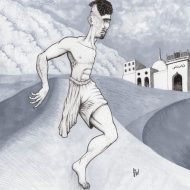Nasnas : The Half Man
Listen
At a glance
| Description | |
|---|---|
| Origin | Arabian Mythology |
| Classification | Hybrids |
| Family Members | N/A |
| Region | Gulf Region |
| Associated With | Kidnapping |
Nasnas
Introduction
In the realm of Arab mythology, the Nasnas emerges as a formidable entity. Within Somali folklore, a kindred creature named “xunguruuf” or “Hungruf” finds its place. The prevailing belief suggests that this entity can extinguish life with a mere touch, leaving a person devoid of flesh in a matter of seconds.
Physical Traits
The nasnas is depicted as “a being half human; possessing half a head, half a torso, one arm, and one leg, which it employs to hop with remarkable dexterity. The Nasnas exhibits remarkable agility on its single leg, relying on its tail to maintain balance during movement. On occasion, it would manifest with a lone, bat-like wing. More frequently, however, it would take on the guise of a feeble elderly man, seeking the aid of unsuspecting individuals to help him cross bodies of water.
Family
The Nasnas is thought to be the progeny of a ‘Shiqq’ and a human. A ‘Shiqq’ represents a lesser form of jinn, a malevolent spirit, and is a creature of grotesque appearance. This interbreeding, therefore, gave rise to a being with a physique that is half-human in nature.
Powers and Abilities
The Nasnas would subsequently transform its shape and submerge its victims. It’s also infamous for lethally assaulting humans using its single hand. Remarkably, the Nasnas never communicates verbally, as half of its vocal cords are absent. Nonetheless, it possesses the ability to emit an eerie, high-pitched, hooting sound, which can be profoundly unsettling to encounter. Depending on the volume and intonation of this hooting, one can discern the Nasnas’s prevailing emotional state.
Modern Day Influence
In “The Story of the Sage and the Scholar,” a narrative found within the collection, a character undergoes a transformation into a nasnas following the application of kohl to one of his eyes by a magician. The nasnas is also referenced in Gustave Flaubert’s work, “The Temptation of Saint Anthony.”
Related Images
Frequently Asked Questions
What is lorem Ipsum?
I am text block. Click edit button to change this text. Lorem ipsum dolor sit amet, consectetur adipiscing elit. Ut elit tellus, luctus nec ullamcorper mattis, pulvinar dapibus leo.
What is lorem Ipsum?
I am text block. Click edit button to change this text. Lorem ipsum dolor sit amet, consectetur adipiscing elit. Ut elit tellus, luctus nec ullamcorper mattis, pulvinar dapibus leo.
What is lorem Ipsum?
I am text block. Click edit button to change this text. Lorem ipsum dolor sit amet, consectetur adipiscing elit. Ut elit tellus, luctus nec ullamcorper mattis, pulvinar dapibus leo.
What is lorem Ipsum?
I am text block. Click edit button to change this text. Lorem ipsum dolor sit amet, consectetur adipiscing elit. Ut elit tellus, luctus nec ullamcorper mattis, pulvinar dapibus leo.
What is lorem Ipsum?
I am text block. Click edit button to change this text. Lorem ipsum dolor sit amet, consectetur adipiscing elit. Ut elit tellus, luctus nec ullamcorper mattis, pulvinar dapibus leo.








